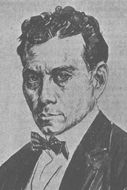Rafael López (1873-1943) wrote a poem entitled “To Lake Chapala” (1927). The poem is a homage to, and parody of, the famous poem “La suave patria”, composed by Ramón López Velarde (1888-1921). (Ramón López Velarde is often considered Mexico’s national poet.)
Rafael López, whose formal name was José Barbarín Rafael de la Concepción López Castañón (!) was a distinguished modern poet, very popular in his time. His work has been favorably re-evaluated in recent years.
 Born 4 December 1873 in the city of Guanajuato, he loved poetry as a child and discovered Amado Nervo at an early age. He wrote to him in verse, thus beginning a long friendship. Nervo helped him publish his first poem, “De invierno”, in a national paper, El Mundo Ilustrado, in January 1899. Other poets in their circle included José Juan Tablada, Jesús E. Valenzuela and Rubén M. Campos. Rafael López was also a close friend of Luis G. Urbina.
Born 4 December 1873 in the city of Guanajuato, he loved poetry as a child and discovered Amado Nervo at an early age. He wrote to him in verse, thus beginning a long friendship. Nervo helped him publish his first poem, “De invierno”, in a national paper, El Mundo Ilustrado, in January 1899. Other poets in their circle included José Juan Tablada, Jesús E. Valenzuela and Rubén M. Campos. Rafael López was also a close friend of Luis G. Urbina.
López moved to Mexico City in 1901 and was a founding member in 1909 of the Ateneo de la Juventud (“Atheneum of Youth“). a grouping of young intellectuals, primarily writers and philosophers. In 1910, López was appointed as instructor in literature at the National Teachers’ College.
Among many other accomplishments, in 1910 Rafael López wrote the lyrics to Mexico’s national anthem, “Canto a la Bandera”, the music to which was composed by fellow Ateneo de la Juventud member Julián Carrillo, inventor of Sonido 13.
López published only two books of poetry – Con los ojos abiertos (1912) and Poemas (1941) during his lifetime, as well as a collection of prose Prosas transeúntes (1925).
Rafael López’s poem “To Lake Chapala” is dedicated to the lake, the then fashionable place to vacation during Holy Week. Here are the original words, with my loose translation into English:
del mar, eres el lírico folleto;
cuna infantil de su flujo y reflujo,
de un soplo, una pompa de jabón
y el pulso de su errante corazón.
El domingo de Pascua, placentera
y fina, en tu recámara playera,
proporcionas al ocio ciudadano
tu ‘agua florida’ y tu ‘espejo de mano’.
Tu alma de moaré bien se acomoda
al capricho del viento y de la moda;
te envuelve el lujo en seda casquivana
y la niebla filosófica, en lana.
Pérfida en ocasiones, no te pierdes
de ser crüel con tus enamorados,
que –naturalmente– han muerto ahogados
en la caricia de tus brazos verdes.
of the sea, you are the lyric booklet;
infant cradle of her ebb and flow
of a breath, a soap bubble
and the pulse of her wandering heart.
On Easter Sunday, pleasant
and fine, in your bedroom by the beach,
you provide for civic leisure
your ‘flowery water’ and your ‘hand mirror’.
Your rippled soul adjusts itself well
to the whim of wind and of fashion;
it envelops luxury in frivolous silk
and philosophical fog, in wool.
Sometimes perfidious, you do not miss
being cruel with your lovers,
who-naturally-have died from drowning
in the caress of your green arms.
Rafael López’s work appeared in numerous poetry collections of the era, as well as in numerous newspapers, magazines and journals, including El Mundo, El Mundo ilustrado, Revista Moderna, Revista Moderna de México, Savia Moderna, La Patria, Arte, Arte y Letras, El Entreacto, Diario del hogar, El Imparcial, El Demócrata mexicano, Novedades, La Nación, Argos, Crónica, La Semana Ilustrada, Revista de Revistas, Nosotros, El Pueblo, Mefistófeles, El Independiente and El Universal.
López published some poems under the anagram “Lázaro P. Feel” (used for a few years during the Mexican Revolution), and pen names such as “José Córdova”, “Tris tris” and “Prevostito”. He maintained his somewhat rebellious attitude to the status quo throughout his life, and remained close to the up-and-coming youthful poets and at the forefront of what was then happening in poetry circles in Mexico. He served as director of the National Archives from 1920 until his death in 1943.
Note:
Julian Carillo and Sonido 13 are the subject of chapter 25 of my Mexican Kaleidoscope: myths, mysteries and mystique (2016).
Sources (Spanish):
Sombrero Books welcomes comments, corrections or additional material related to any of the writers and artists featured in our series of mini-bios. Please use the comments feature at the bottom of individual posts, or email us.
Tony Burton’s books include “Lake Chapala: A Postcard History” (2022), “Foreign Footprints in Ajijic” (2022), “If Walls Could Talk: Chapala’s historic buildings and their former occupants” (2020), (available in translation as “Si Las Paredes Hablaran”), “Mexican Kaleidoscope” (2016), and “Lake Chapala Through the Ages” (2008).